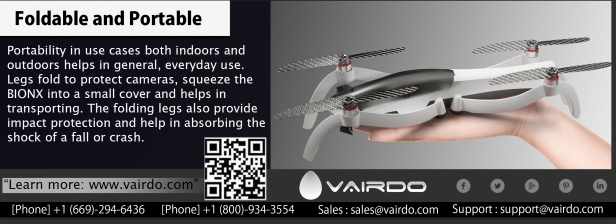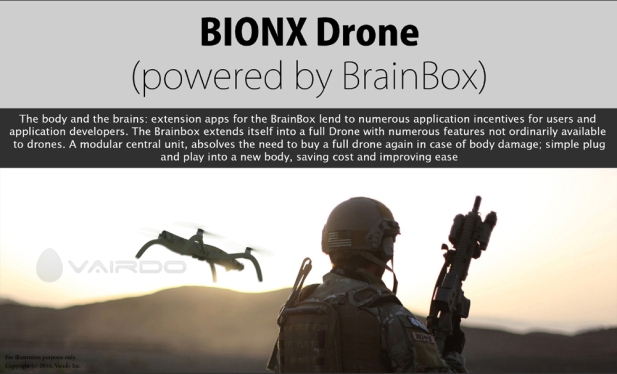Introduction
The ability for vehicles to navigate unknown places is critical for autonomous operation. Mapping of a vehicle’s environment and self-localization within that environment are especially difficult for an Unmanned Aerial Vehicle (UAV) due to the complexity of UAV attitude and motion dynamics, as well as interference from external influences such as wind. By using a stable vehicle platform and taking advantage of the geometric structure typical of most indoor environments, the complexity of the localization and mapping problem can be reduced. Interior wall and obstacle location can be measured
Figure 1: Twin HD Cameras: BrainBox @
VAIRDO Inc.
using low-cost range sensors and smart computing micro cameras. Relative vehicle location within the mapped environment can then be determined. By alternating between mapping and localization, a vehicle can explore its environment autonomously. Work at Georgia Tech @ GTSR (
http://www.gtsr.gatech.edu/) utilizes smart micro cameras and sensors for suitability in solving the mapping and localization problem. A control system and navigation algorithm are developed to perform mapping of indoor environments and localization. Simulation and experimental results are provided to determine feasibility of the proposed approach to indoor navigation.
Collaborative Work at Georgia Tech (Georgia Tech Systems Research Lab and VAirDo Inc.)
The Georgia Tech Systems Research (GTSR) Group has built biologically inspired robotic blimps that supports research and education in motion control, environmental mapping, and human robot interaction in three dimensional space. The GTSR group, Directed by Dr. Fumin Zhang, have produced several working prototypes of computer controlled aerial indoor blimp platforms that offer long flight and loiter times, and safe, stable, low noise operation. The GTSR blimp design balances speed and maneuverability in an indoor environment, with on board feedback control to achieve precision in 3D trajectory tracking. The blimps’ hardware and software systems were designed to support a variety of payloads towards applications such as providing communication support, eyes in the sky (or on the ceiling), and guiding, mapping services for a broad scope of real world applications. The GTSR blimp has recently received a 3rd place award from the video contest of the IEEE control systems society:


Figure 2:
OCURA, VAIRDO inc. – Wireless connectivity and Video Transmission
The blimps’ hardware and software systems were designed to be adaptable to support research on environmental sensing and human robot interaction. Robotic blimps are useful for providing communication support, eyes in the sky (or from the ceiling – indoors), and transportation services for a broad scope of real world applications. The main aim of indoor aerial navigation is to have precision while moving in a controlled manner, thus maintaining a stable hover requires continuous control updates. As such, a large number of previous research efforts have been dedicated to design and testing of automatic flight control algorithms designed to stabilize small aerial vehicles such as blimps.
Various flight control techniques used for this application include, but are not limited to, vision-only navigation and control using a UKF, loosely coupled GPS/INS integration using a UKF, and camera and IMU updates to a UKF for a trajectory generator; The camera and video are being relayed wireless to the ground station using the
BrainBox package by Vairdo Inc.
Although the end goal is to autonomously navigate unknown GPS-denied environments, the first step is to build a model-based hover controller which utilizes an external optical tracking system recently installed in AFRL’s MAV-IFF.
The IFF uses motion capture cameras to provide accurate position and orientation information to a real-time controller which in turn relays commands through an RC transmitter to any off-the-shelf or uniquely-designed vehicle. This real-time motion capture facility is one of a handful in the US.
Other organizations using similar facilities for controller design and testing include MIT (Aerospace Controls Laboratory – RAVEN), Georgia Tech, and Boeing, which have produced useful results mostly within the past year.
BrainBox from VAIRDO Inc. powers the wireless video feed and The Ground station utilizes twin HD cameras for vision based applications; there is also a high speed Optical Flow camera available on the BrainBox for navigations and stabilization purposes for the blimps as an upgrade
Golden Quotes from Dr. Fumin Zhang
“Mobility poses great challenges to the Internet of Things when networked mobile agents are concerned. Distributed sensing and control will need to be coordinated through information exchange over flexible ad-hoc wireless networks to guarantee sustainable, reliable and affordable data streams flowing across the network. Insights into the coordination and decision making mechanisms used by animal groups serve as a source of inspiration for my research to solve these problems
The Various application of Blimps for aerial navigation are as under:
• Indoor Surveillance.
• Vision based Sensing Platform for Research Purposes.
• Miniaturized technology serving as a boon for defense and security.
• Low communication Links or Dynamic Routers.
Applications are many as the technology is under regular phase of evolution every now and then.
VAIRDO – Flying Micro

VAIRDO is in the business of providing custom and pre-configured miniaturized imu, computing, control and sensing platforms for industries from virtual reality smart weapons, compact mini drone sensor & controls, video monitoring and deployable sensors, Robotics, Unmanned systems, consumer electronics. Our markets are in the Military, R&D, consumer electronics and B2B solutions. “We pride ourselves in making the world’s most cutting edge, smart and compact sensor, electronics and control systems being used in applications involving computer vision, wireless telemetry and smart computing/sensing. Cutting edge robotics solutions to meet high demand autonomous hardware solutions on Land, Air and Water and can be efficiently used for microdrone, pocket drone, micro robotics, quadcopter, live streaming, aerial videography, auto pilot, indoor navigation, GPS flight etc. Our work covers complex aerodynamics, avionics, micro aerial vehicles, rethink robotics, bio-inspired projects, drones & UAVs, micro robotics, large alternate energy flying vehicles and much more. We breathe micro hardware, smart computing and innovative compact sensor and control solutions for various industries Robot brain to flying bots to consumer electronics, complex gear train systems, mathematics, dynamics and kinematical hardware systems, we have expertise to do it all. Android, Matlab applications
The heart of a full high-performance embedded development kit environment; size smaller than the palm of a hand; and performance matching Smartphones, Tablets and high computing mobile devices.
Gimbaled Stereo Camera with HD
Dual 5Mega pixel gimbaled 4K HD wireless Go pro cameras, useful for Long range Depth Estimation, 3D estimation, Onboard intelligence, mapping, gesture control, Headcount or rotating camera, stabilizing your selfie images/videos, point and shoot, follow-me applications, Stereo Vision Computer Vision.
Smartphone connectivity with WIFI communication
Quad core computing with modularity
Quad-core ARM® Cortex with Pre-loaded 4.2.2 Android operating system (upgradable). Modularity of Brainbox helps it upgradable with new releases of components. All boards, cameras and antennas are upgradable and plug & play.
Shock Absorption with Dual Redundant Sensing
Keeps applications working smoothly, prevents damage and disturbance. Impact resilience and prolonged structural integrity. Survives in the toughest of scenarios and higher sensing accuracy, lower standard deviation of data and great backup in case of failure
Blimps with Brains
Figure 4: Brainbox for computing, sensing and control
Together with the excellent engineering team at GTSR with focus, strength in autonomous indoor navigation, Vairdo is seeking to improve the software and control for a new generation of flying drones.
Blimps provide exceptional long endurance guidance, monitoring, reconnaissance but are limited in the amount of payload they can carry owing to the limited buoyancy of Helium or Hydrogen. The slim, compacted and light BrainBox modules are ideal for such applications and can provide complete control authority, sensing and computing needed for the most complex of R&D tasks or real-world jobs. The R&D effort between GTSR and VAIRDO is ongoing and the intellectual prowess of students, faculty at Georgia Tech, coupled with the industry experience in micro robotic hardware, multiple novel innovations are forthcoming to help in real-world scenarios, search & rescue and much more!
Scan the QR Codes to get your acquainted with the ‘Brain Box” and how it empowers Blimps.
Georgia Tech Lab Work Video I Georgia Tech Lab Work Video II Introduction to Brain Box – VairDo Inc.
For More Information :
Vairdo Inc
79 Bonaventura Dr. NW
San Jose, CA - 95134
[Phone] +1 (669)-294-6436


























